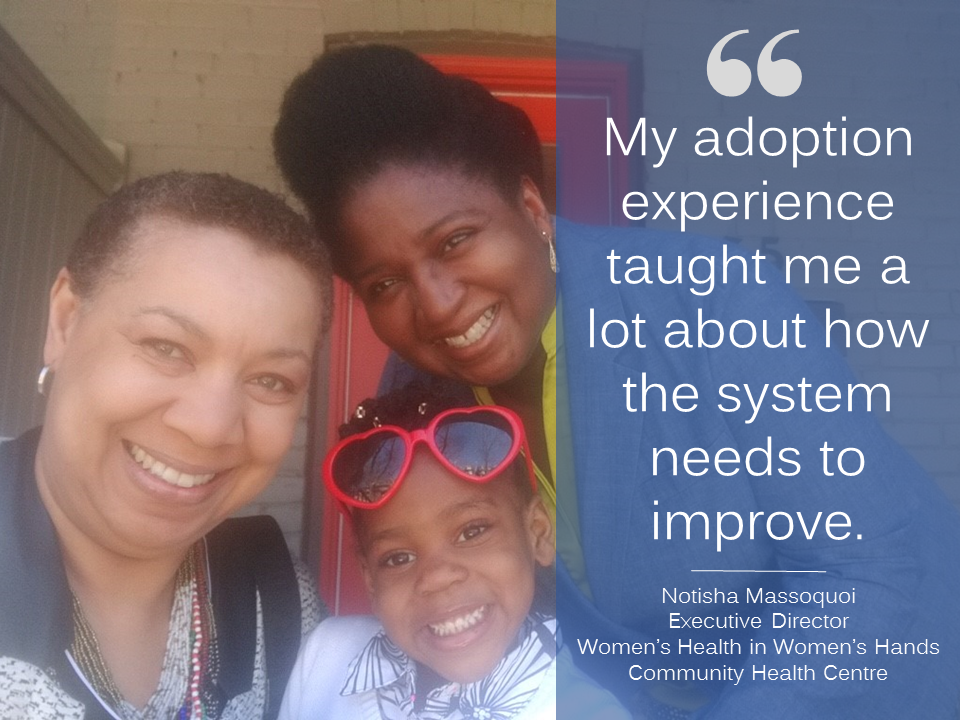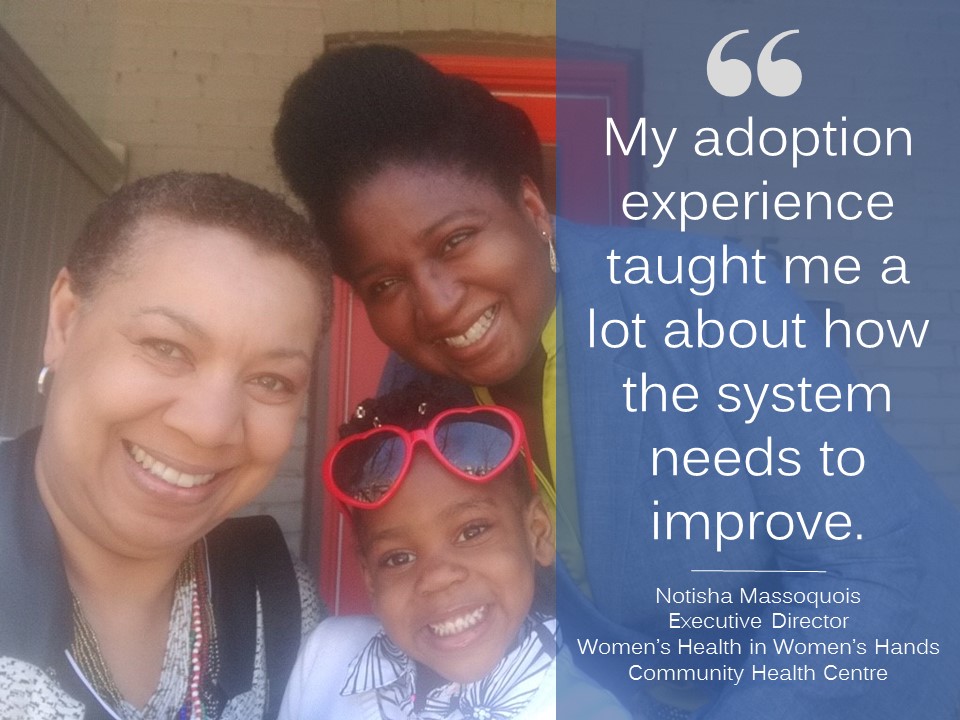The recently released One Vision One Voice Research Report and Race Equity Practices is intended to support Children’s Aid Societies as they begin the process of deep change needed to better serve African Canadian families. As a complement to this framework, there is a great deal that can be learned from individual experiences. Two years ago, Notisha Massaquoi adopted her daughter through a Children’s Aid Society. She shares her insights on how the system needs to improve.

Last year the One Vision One Voice: Changing the Ontario Child Welfare System to Better Serve African Canadians released a research report and Race Equity Practices to support Children’s Aid Societies make positive change. Were you involved in this project?
I am the executive director of a women’s health centre that frequently works with women who are involved with Children’s Aid so it made sense for me to be part of the One Vision One Voice project. But the project launched at the same time that we started the process to adopt a child, so I felt it would be a conflict of interest to participate. My adoption experience taught me a lot about how the system needs to improve, so I spoke about my experience during the One Vision One Voice consultations with the African Canadian community. I also spoke at the Symposium launch of the Practice Framework in the hopes that sharing my experience can help make positive change.
What did your experience tell you about how the child welfare system is currently serving African Canadian families?
The process to adopt was very onerous for my partner and I’m somebody who knows the system. And if we’re struggling racially and culturally through the adoption process, what about the average African Canadian family wanting to adopt?
Can you give some examples of how you and your partner struggled racially and culturally through the adoption process?
Throughout the process – we were the only black couple – they kept telling us that we were going to have an easy time adopting a child, as if it were a good thing. As a black woman sitting in a room and being told I have this whole pool of children to draw from I don’t immediately think “Great.” I immediately go to, “Oh my god. Look at how many women have lost children.”
Another example of cultural insensitivity would be the home evaluation you have to go through in order to adopt. A lot of this evaluation involved the adoption worker trying to understand the two black women in front of her, whether it was explaining African spirituality, or deconstructing my family tree for her understanding. The process makes you feel not normal. This lack of cultural competence meant I had to redact so much that was written about us. My partner was described as “exotic.” My partner’s half-sister was described as “illegitimate.” And the only reference to my employment was my work in a woman’s abuse shelter 19 years ago. There was no reference to the fact that I have been a lecturer at Ryerson in the Faculty of Social Work for ten years, and an executive director at a women’s health centre for the past 12 years. I felt the way we were constructed was very stereotypical and racist.
Your daughter lived with a foster family for two years. What is your perspective on her experience with them?
Our experience with our daughter’s foster family was a negative one. I am going to be straight with you. They were racist. She had been living with them from the time she was five weeks old. When we adopted her she wouldn’t look at herself in the mirror. She wouldn’t hold black dolls. When she looked at representations of black kids in books she would say they were ugly. She was terrified of black men. She had learned this in her foster home where there were no culturally specific toys, dolls, or pictures. When we brought her a little black doll her foster parents switched it out with a white doll. And because they said she was afraid of black men, they wouldn’t allow black men in their home.
All these details are very specific to how your identity is formed. We had been told that our two-year old daughter had serious developmental issues. In fact, it turned out that our daughter has no developmental learning issues. What I actually had to spend all my time on was my child’s racial identity and self-esteem. My work was to give her the confidence to hold up her head and walk in the world, which had been taken away from her.
How did knowing that African Canadian families are overrepresented in the child welfare system influence your approach to adopting your daughter?
Our main goal when we started out the adoption process was not to perpetuate the systemic issues that are leading to the overrepresentation of black children in care. I was very clear in our application about the non-negotiables. We only wanted an open adoption with family involvement, and the mother could not be a client of my agency. I come from a culture where it is not unusual for a friend or family member to step in because ‘mum is just not doing well right now’, and that is how we wanted our role as adoptive parents to be. Parenting my daughter for me is to minimize the impact on her birth mother and her other children. The other scenario – the one where her mother gets punished for the rest of her life and never gets to see her child again – is the scenario I cannot do.
So you have opened up contact with your adopted daughter’s birth family?
We have started out by building a relationship with our daughter’s sister, who is 18 years old. She saw her sister leave the house and yet didn’t know where she was. There was no effort made to maintain contact between the siblings while they were in foster care. When she first saw our daughter she cried. The two are more attached than I could have ever expected. She comes to my daughter’s recitals. And when she graduated from high school, we were there.
What do you understand about how your daughter came to be in care?
Our daughter came into care because of a situation of poverty. If I had gone through the same situation as our daughter’s birth mom, my child would not have been in care and Children’s Aid would not have been involved because I have a strong knowledge of the system and how to get help, financial resources, and a strong network of family and friends. Our system is failing certain families.
The One Vision One Voice Project recently released its Practice Framework to support Children’s Aid Societies to better serve African Canadian families. What role do you see for yourself in helping make these changes happen?
Through my work at the women’s health centre I am making an effort to build very proactive ways of working with Children’s Aid to provide the supportive wraparound care that allows children to stay in their homes if they are not in danger. Children’s Aid is not understanding the impact they have had on our community, but with this kind of approach I am hopeful we can repair our relations and rebuild how we serve the African Canadian community.
